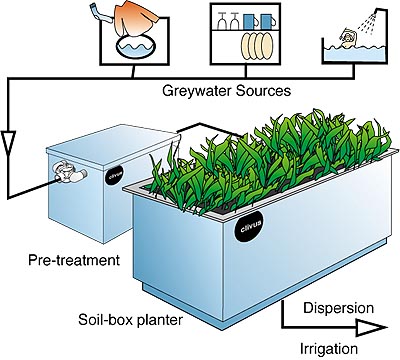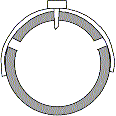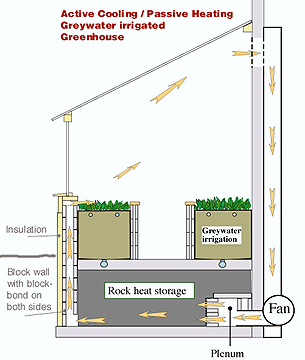

Aerobic Pre-treatment -- suitable for showers, hand-washing and laundry* water treatment.
The aim of this stretch filter treatment technque is simply the removal of large
particles and fibers to protect the subsequent infiltration pipes from clogging
and transferring it as soon as possible for treatment into a biologically active,
aerobic soil-zone environment where both macro- and microorganisms can thrive.
Stretch-filters are made to retain fibers and large particles and allow the
rest of the organic material to travel on to the next stage of processing. This
filter is suitable for public facilities where the principal source of greywater
is hand-washing and showers without any food waste to speak of. If this type
of filter is used to remove food wastes, these will accumulate in the filter
which then becomes anaerobic and makes the effluent malodorous.The result is
often that too frequent changes of the stretch-filter becomes necessary ---thus
creating an undesirable, high-maintenance situation. See diagram below for a
typical Clivus greywater management fabric filter configuration:

A very interesting replaceable filter technology from Finland is called Willa Eco-matic and consists of a fiber and ion-exchange media enclosed in a sack that can be lifted out of the container and replaced when slow or otherwise determined to be needed -- preferebly according to a regular service and maintenance schedule.

*Beware of the use of harsh detergents and bleach if the water is to used in or near gardens growing edible plants. Some surfactants are associated with controversial hormone-mimicking characteristics that we need to be aware of. We also need to be aware of handwashing soap containing antibacterial chemicals which are totally unnecessary and do not improve cleansing.
Anaerobic to aerobic pre-treatment
If any significant quantity of food waste enters the system from
dishwashers and kitchen sinks receiving cooking grease and a fair
amount of food residue, this option is recommended. A typical
installation is not very different from a traditional system; but the
treated effluent is of much better quality and does not pollute
nearly as much. Ideally, it should consist of a three-stage septic
tank for sludge and grease separation. The separated sludge can thus
be removed less frequently [every fourth year instead of
bi-yearly as is standard practice with many conventional
systems]. The outgoing effluent in the septic system is
anaerobic. Following the septic tank is a sandfilter designed for
restoration of aerobic conditions. The final treatment stage leading
to purified water of near potable-quality is treatment in a planter
bed. This is not the most inexpensive solution. It is, however, one
of the most effective,simple-to-maintain on-site treatment techniques
available today.

Grease-trap/septic tank + sandfilter + sample/pump pit
 |
 |
 |
 |
Clockwise from top left:
1. Three-chamber septic tank
2. Sandfilter with a geo-textile cloth (courtesy of Civil Eng. Hans Lönn, Älgö Sweden)
3. Final result from the sandfilter (swimming-quality water)
4. Close-up of the effluent: odor-free, clear and suitable for planter irrigation.
Planter soilbox design
Soilboxes have been used for greywater purification since 1975 with excellent results. The planter bed has to be well drained to prevent the formation of a water-logged zone in any part of it. Therefore, its bottom contains a layer of polyethylene "actifill" or pea gravel to provide effective drainage. A layer of plastic mosquito-netting on top of the actifill prevents the next layer of coarse sand from falling through. On top of the coarse sand is a layer of ordinary concrete-mix sand, while the top two feet consist of humus-rich top soil. Clay soils must not be used.

Figure 1a
Water injection without erosion
The pressure infiltration pipes are designed to allow for even distribution of the water even on uneven terrain. They are easy to clean and should be placed on the soil surface after planting and then covered with a 2 to 4-inch-thick layer of wood chip mulch. In cold climates the change from shallow infiltration to a deeper layer can be accomplished by an automatic switch-over (as described below in Fig. 9). The pressure infiltration piping (shown above) consists of two concentric pipes, the inner one having holes pointing up and the outer sleeve fitting snugly over the inner pipe and somewhat expanded by the water pressure when ON. This causes the water to" bleed" out along the slot at the bottom. Water pressure OFF makes the sleeve close, preventing worms, insects and roots from entering the pipe and clogging it from the inside. Piping is available in 5-ft sections and can easily be coupled together through a quick-connect system. These pipes are easily cleaned without disassembly.
 |
 |
Gravity or pressure leaching chamber
Hanson Associates of Jefferson, Md., reports that leaching chambers have operated successfully at a loading of 2.4 gal/sq. ft. per day receiving all the greywater from a three-bedroom house. Using half a PVC pipe 6" diameter according to the figure below, this leaching chamber can be placed in a trench on a 1-2 inch mesh plastic netting (to prevent the walls from sinking into the soil). No pre-filtration is used--only a dosing pump chamber pumping every 8 hours.

Sizing for a residence
3 bedrooms @ 150 gal/b.r. = 450 gal/day. Subtract 50% for no-flush toilets and reduced-flow shower heads etc. = 225 gal/day. The minimum trench surface area is therefore around 100 sq ft using a loading rate of around 2-2.5 gal/sq. ft/day
Specify:
5-20 feet long and 1 foot wide trenches.
Flooding dose:
100 sq. ft x 1" desired water depth = 62 gal per dosing
Dosing chamber can be a Clivus LPF pre-treatment filter container without the stretch filter.
Gravity switch from shallow to frost-free zones/levels
Figure 3 shows an example of automatic switching from the shallow leach chamber to one which is below the frost line. If the shallow trench freezes and becomes clogged with ice, the water will back up and spill over into the pipe for the deeper trench. It should be noted that greywater is warmer than combined sewage and that, therefore, shallow leach zones in operation tend to stay free of ice much longer than is normally expected of combined waste waters. One notes a warming of the soil and biological activity which make freezing rare even in fairly cold climates.

Automatic switching of levels using pump pressure is somewhat different from gravity pressure. In this case, a loop has to be arranged indoors where the pressure needed for the shallow infiltration normally is lower than the pressure required to force the water up to the top of the loop. The top of this loop must, of course, not exceed the shut-off head of the pump. A margin of around three feet of water is desirable. Figure 4
The system can equally be designed to be switched manually by the opening and closing of the valves feeding the different zones/levels.

Other Cold Weather Options
There are several greywater-irrigated greenhouses located in New England. Some of these have been in operation since the 1970's and feature a combination of automatically irrigated and fertilized growing beds which provide effective greywater treatment. One 12 ft x 36 ft greenhouse near Concord, NH uses as the final treatment--after the soil beds--a fish pool, which stays clear by means of a biological treatment technique involving a waterfall and bio-filter plates on the pool-bottom(21). Deep soil beds tend to store heat both from the sun and from the greywater itself. The New Hampshire greywater-irrigated greenhouse is the top cold climate producer of salad greens in the US according to a survey carried out by A. Shapiro at the National Center for Alternative Technology (22).

Figure 5
This greenhouse provides a family of 4 - 6 people with more than enough salad greens throughout the long New England winter. Winter vegetables grown in it include broccoli, spinach, lettuce, mustard greens and sorrel (see below) (15).
Another simple way to facilitate better distribution of the greywater in the soilbed is to make a pipe-loop that is fed from both sides -- see the sketch below:

Figure 6
 |
Out-door planters
There are several variations on the theme of outdoor raised soilbeds that effectively replace the soil needed for an effective leach field treatment of waste water. Houses on ledges or very sandy soils that would not effectively slow down effluent sufficiently to accomplish treatment can be fitted with masonry soilboxes which, in effect, serve to build up the site's soil profile. This strategy has been used in so- called mounds or Evapo-Transpiration beds (the name derived from the often erroneous assumption that all the water will evaporate to the atmosphere even in wet and cold climates).
In areas where the density of construction makes it difficult or impossible to build up a large mound or to locate planters on the property for treating the volume of effluent produced, two adjacent neighbors can agree to build property dividers and plant hedges or evergreens as their leaching area. This space-saving alternative combines privacy and aesthetics with good environmental protection. Greywater gardens as depicted above can offer the added benefit of one's being able to garden at a back-saving height...
In colder climates, treatment will be less effective during the winter season, and at times there may even be trouble as a result of freezing. However, this is often less of a technical problem than it may seem to be at first glance:
-When relatively warm greywater is injected into the soil, increased biological activity as well as a warming of the soil tend to keep the injection zone unfrozen longer than surrounding areas.
-In rural or suburban locales, raised beds/planters may often be ideal for use as leaf "compost bins" in the fall. The leaves act as an insulator as well as a composting fuel-source that further insures that the soil underneath does not deep-freeze.
Shallow subsoil (i.e., at 2-6 inches below soil-level) irrigation is preferable to surface irrigation
|
|
|
|
|
|
|
|
|